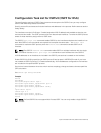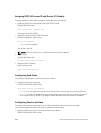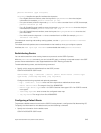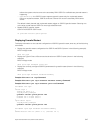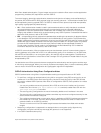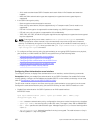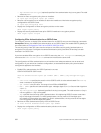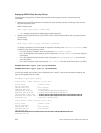
– AH is used to authenticate OSPFv3 headers and certain fields in IPv6 headers and extension
headers.
– MD5 and SHA1 authentication types are supported; encrypted and unencrypted keys are
supported.
• In an OSPFv3 encryption policy:
– Both encryption and authentication are used.
– IPsec security associations (SAs) are supported only in Transport mode (Tunnel mode is not
supported).
– ESP with null encryption is supported for authenticating only OSPFv3 protocol headers.
– ESP with non-null encryption is supported for full confidentiality.
– 3DES, DES, AES-CBC, and NULL encryption algorithms are supported; encrypted and unencrypted
keys are supported.
NOTE: To encrypt all keys on a router, use the service password-encryption command in
Global Configuration mode. However, this command does not provide a high level of network
security. To enable key encryption in an IPsec security policy at an interface or area level, specify 7
for [key-encryption-type] when you enter the ipv6 ospf authentication ipsec or ipv6
ospf encryption ipsec command.
• To configure an IPsec security policy for authenticating or encrypting OSPFv3 packets on a physical,
port-channel, or VLAN interface or OSPFv3 area, perform any of the following tasks:
– Configuring IPsec Authentication on an Interface
– Configuring IPsec Encryption on an Interface
– Configuring IPSec Authentication for an OSPFv3 Area
– Configuring IPsec Encryption for an OSPFv3 Area
– Displaying OSPFv3 IPsec Security Policies
Configuring IPsec Authentication on an Interface
To configure, remove, or display IPsec authentication on an interface, use the following commands.
Prerequisite: Before you enable IPsec authentication on an OSPFv3 interface, first enable IPv6 unicast
routing globally, configure an IPv6 address and enable OSPFv3 on the interface, and assign it to an area
(refer to Configuration Task List for OSPFv2 (OSPF for IPv4)).
The SPI value must be unique to one IPsec security policy (authentication or encryption) on the router.
Configure the same authentication policy (the same SPI and key) on each OSPFv3 interface in a link.
• Enable IPsec authentication for OSPFv3 packets on an IPv6-based interface.
INTERFACE mode
ipv6 ospf authentication {null | ipsec spi number {MD5 | SHA1} [key-
encryption-type] key}
– null: causes an authentication policy configured for the area to not be inherited on the interface.
– ipsec spi number: the security policy index (SPI) value. The range is from 256 to 4294967295.
– MD5 | SHA1: specifies the authentication type: Message Digest 5 (MD5) or Secure Hash Algorithm
1 (SHA-1).
– key-encryption-type: (optional) specifies if the key is encrypted. The valid values are 0 (key is
not encrypted) or 7 (key is encrypted).
650
Open Shortest Path First (OSPFv2 and OSPFv3)



